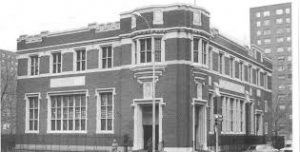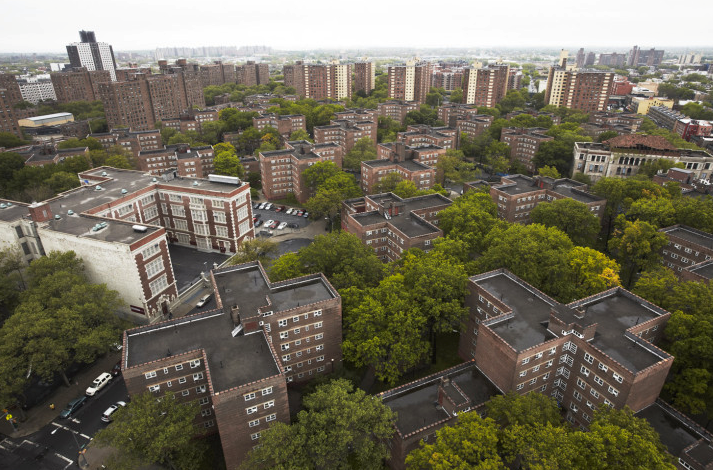Or not, was the point of a community conversation last month in Brownsville-- a 2.19 square miles community located in Eastern part of Brooklyn.
The conversation would take us beyond the dealings of disease in the way people are accustomed to and into the social and economic factors that determine our health.

Despite the extremely frigid weather that evening, the room on the top floor of the Heritage House, a cultural treasure that sits above the Brownsville library, was filled to capacity.
On January 23, community residents, health professionals and high school students came through to hear a Brownsville native-- who happens to be the head of the top-rated Johns Hopkins Bloomberg School of Public Health-- Dr. Thomas LaVeist, the evening's special guest.
He came back to visit and re-explore Brownsville after 20 years. Andre Mitchell, Founder of Man Up!, Lisa Kenner- President of the Van Dyke Houses Tenant Association, Harvey Lawrence — CEO of Brownsville Multi Service Family Health Center along with two recent high school graduates from WATCH; a local high school with a strong focus on community health also joined the conversation to share knowledge and experience.
According to the Office of Vital Statistics in NYC in 2011 and 2012, Brownsville as compared to the rest of NYC had the highest death rates from all causes, the highest cancer rates, the highest rates of heart disease and the highest rates of pre-pregnancy obesity from 2007-2009.
From 2009-2011, Brownsville had the highest infant death rates, which is death of an infant prior to their first birthday.
To more fully illustrate what impacts the health of Brownsville, the panel participants also examined the environmental factors such as community safety and violence as well as what socially determines health also known as the root causes of disease such as if one is employed, how much money one makes, what is their level of formal education, what is the quality of housing, and their experience with real and perceived racism.
Brownsville has the nation's largest concentration of public housing in the US. This housing 'project' was conceived in the 1940s by then NYC Parks Commissioner Robert Moses with approval of the NYC Mayor Fiorello LaGuardia with intention to house the large number of Blacks migrating from the South and in "areas where there is not the slightest possibility of rehabilitation through private enterprise."
There are over 100 buildings with thousands of people, figuratively and literally, living on top of one another. Knowing this, along with people fighting to survive to meet their basic individual and family needs in an economically challenged community, makes it easier to understand why Brownsville has the highest homicide rates than any other neighborhood in NYC.
A little over a third of the families have incomes under $15,000, half of the families receive public assistance, and the employment rate is 19% (compared to about 11% city-wide). It is one of the communities with the highest number of families entering homeless shelter in NYC.
When you Google Brownsville, New York, the results initially reveal language like "the 'hood left behind", "Brooklyn's most dangerous", "man shot in head", "high-rise on fire", and "terrorized by gangs."
All of it seemingly bleak, and is unfortunately the label that Brownsville carries in the minds of many. However, as one continues to click through the pages you will begin to see reference to a youth farmers market on Pitkin Avenue, the Brownsville Library which opened in 1905 and that the first library in the US dedicated exclusively to children was built here in 1914.
You'll also find the Recreation Center, once led by the revered Greg "Jacko" Jackson who passed a few years back, the Multiservice Family Health Center, a Brownsville dedicated Facebook page, and the Brownsville Heritage House, a multicultural center, founded by Mother Gatson due to the void in community knowledge regarding culture.
There are organizations such as The Municipal Art Society, Brownsville Partnership, and Community Board 16 all committed to the health and well being of Brownsville residents, many of who were present in the audience.
The panelists explained these assets, deemed as community strengths, have in part supported Brownsville's resilience through the hard times. These assets are paramount, and provide the foundation on which communities are built and are ultimately strengthened.
When assessing the health of a community, there is tremendous familiarity and a tendency to highlight and exclusively focus on the deficits of a community, especially Brownsville. This potentially begins to evade the entire belief system, not only outsiders, but of Brownsville residents in regards to their capacity and ability to ignite change.
A regularly touted phrase by the health community "We have to empower our communities to take care of themselves" implies that communities and its residents are powerless.
This conflicts with the process and nature of empowerment in which people take control over their lives and the social and political environments in which they live.
It also doesn't fully appreciate the perceived notion from communities with many stressors such as poverty and high crime that they as individuals and communities lack of control over their own destiny especially in health.
When asked what is the greatest asset and strength in Brownsville, all panelists agreed- the people; starting with the panelists and the community residents in the audience. By default, their presence demonstrated a particular type of leadership and commitment to learning more and using the power of their voice to share.
There was strong consensus that Brownsville youth offer the greatest hope to lead and sustain transformation for themselves and the community at large.
By the end of the evening, the illuminating take home message was that in order to build Brownsville in health, we must create a better balance between understanding need while most importantly promoting and actively engaging with people.
The process in which this achieved — balancing power and valuing community expertise and experience- is as equally important as achieving the desired outcome of optimal health in a community.
And then hopefully if done "right" and one day when we Google Brownsville, we will read an article that is reflective of the title that Brownsville is the healthiest neighborhood in NYC.




